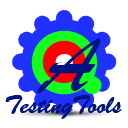Main menu
Tool Scope
Testing Methods
Testing Objectives
- API-testing
- Application-Life-Cycle-Tracking
- Application-Logic-Testing
- Back-End-Service
- Back-end-Stress
- Banking-Process-validation
- Big-Data-Testing
- Binary-Static-Analysis
- Binding-Unit-Testing
- Code-Analysis
- Code-Coverage-testing
- Code-Review
- Code-Tracability
- Coding-Standards-verfication
- Cross-Platform-Testing
- Cross-Browser-testing
- Data-Flow-Analysis
- Data-Interface-Testing
- Data-Migration-Testing
- Data-Warehouse-Testing
- DataBase-testing
- Database-Upgrade-Testing
- Desktop-testing
- EMail-Testing
- Embedded--Software
- ETL-Testing
- Http-Unit-Testing
- Image-Based-Testing
- Image-Comparison
- Interoperability-testing
- Java-testing
- Load-Capabilities
- Log-Tracking
- Memory-Analysis
- Memory-Leak-Detection
- Message-testing
- Metrics-Analysis
- Mobile-Testing
- Network-testing
- Object-Based-Testing
- OWASP-Top10-Testing
- Pair-Wise-Analysis
- Payload-Validation
- Penetration-testing
- Performance-Analysis
- Plugin-testing
- Protocol-Testing
- Runtime-Error-Detection
- SANS-CWE-Top25
- SAP-Testing
- Security-Testing
- SEO
- Server-testing
- SOA-testing
- Static-Code-Analysis
- Stress-Testing
- Test-Cases-Statistics
- Test-Design
- Test-Embedded-systems
- UI-testing
- Uptime-Testing
- WCF-services
- Web-Monitoring
- Web-Services
- Web-testing
- Website-Speed-Testing
You are here
Web service protocols
SOA and Web service protocols Implementers commonly build SOAs using web services standards (for example, SOAP) that have gained broad industry acceptance. These standards (also referred to as Web Service specifications) also provide greater interoperability and some protection from lock-in to proprietary vendor software. One can, however, implement SOA using any service-based technology, such as Jini, CORBA or REST. Architectures can operate independently of specific technologies. Designers can implement SOA using a wide range of technologies, including: SOAP, RPC, REST, DCOM, CORBA, Web Services, DDS, WCF (Microsoft's implementation of Web Services now forms a part of WCF) Implementations can use one or more of these protocols and, for example, might use a file-system mechanism to communicate data conforming to a defined interface-specification between processes conforming to the SOA concept. The key is independent services with defined interfaces that can be called to perform their tasks in a standard way, without a service having foreknowledge of the calling application, and without the application having or needing knowledge of how the service actually performs its tasks. Many implementers of SOA have begun to adopt an evolution of SOA concepts into a more advanced architecture called SOA 2.0. SOA enables the development of applications that are built by combining loosely coupled and interoperable services. These services inter-operate based on a formal definition (or contract, e. g., WSDL) that is independent of the underlying platform and programming language. The interface definition hides the implementation of the language-specific service. SOA-based systems can therefore function independently of development technologies and platforms (such as Java, .NET, etc.). Services written in C# running on .NET platforms and services written in Java running on Java EE platforms, for example, can both be consumed by a common composite application (or client). Applications running on either platform can also consume services running on the other as web services that facilitate reuse. Managed environments can also wrap COBOL legacy systems and present them as software services. This has extended the useful life of many core legacy systems indefinitely, no matter what language they originally used. SOA can support integration and consolidation activities within complex enterprise systems, but SOA does not specify or provide a methodology or framework for documenting capabilities or services. High-level languages such as BPEL and specifications such as WS-CDL and WS-Coordination extend the service concept by providing a method of defining and supporting orchestration of fine-grained services into more coarse-grained business services, which architects can in turn incorporate into workflows and business processes implemented in composite applications or portals. Service-oriented modeling is an SOA framework that identifies the various disciplines that guide SOA practitioners to conceptualize, analyze, design, and architect their service-oriented assets. The Service-oriented modeling framework (SOMF) offers a modeling language and a work structure or "map" depicting the various components that contribute to a successful service-oriented modeling approach. It illustrates the major elements that identify the “what to do” aspects of a service development scheme. The model enables practitioners to craft a project plan and to identify the milestones of a service-oriented initiative. SOMF also provides a common modeling notation to address alignment between business and IT organizations. SOMF addresses the following principles: • business traceability • architectural best-practices traceability • technological traceability • SOA value proposition • software assets reuse • SOA integration strategies • technological abstraction and generalization • architectural components abstraction
- Log in to post comments
MANUFACTURERS Wallboard
Theme by Danetsoft and Danang Probo Sayekti
